Oh
god why did I decide to write this?
When
you say ‘I’ll have to have a look at that’, that’s what this style or article
is: a Look At article (or series of articles) isn’t a review per say it’s far
more informal, I read and watch a lot of things per week – I suffer from Depression,
suicidal thoughts, paranoia (not always all at the same time) and have a very
low threshold for boredom, (I’m full diagnosed, even with the boredom thing,
well technically the doctor didn’t diagnose that, his really pissed of secretary
did, but she’s almost a doctor right?)
so I like to be doing something in an
attempt to keep my mind from focussing on all the horrible depressedness
swilling around in it, I came up with this idea to give some added bonus purpose
to all that watching and reading, you could argue that it’s already serving a
purpose (to entertain me and to keep my mind off my mind wanting me to die) and
you’re right, but it’s always nice to have an added bonus purpose. I wanted my first Look At to be something
meaningful, one of my favourite stories or series, maybe something TMNT or Sonic
the Hedgehog related, it ended up being The Multiversity – there is no
significance to this ‘Mega Series’ being the first event, in fact I have no
idea why I wrote it, in fact all the way through I was thinking ‘why am I writing
this?’ but write it I did. I’m actually a little disappointed because I’m
writing this intro after I’ve written the whole series of posts (I often write
the intros last, shhh) and I know this isn’t going to be a very positive Look
At and that’s not the impression I wanted to give, I’m not a critic, I don’t
want to be one, I’m not trying to be Linkara or…that other bloke on Channel
Awesome who does comics, I’m not going to be choosing what gets a Look At
because it needs slagging off,I’m not even choosing things to Look At that can
get me a good post, in fact I think as I’ve just proven I’m not choosing what
gets a Look At for any good reason at all half the time, I’m just talking about
something I’ve read or watched. ANYway…
The
Multiversity was 2014-2015 Event from DC Comics, one of the few readable things
to be put out after the New 52 revamp in 2011, mostly because it wasn’t set on
Earth-0. We used to call these ‘Micro-Series’ or ‘fifth week events’ but now
they’re known as Mega Series – a set of one-shots with different titles but
telling an overall story like a mini-series would, usually bookended by a
two-part series usually under the name of the event (all of this is true in the
case of the Multiversity) – the new name is presumably because it no longer functions
as a fifth week event (filling a hole in the published schedule) and as part of
everyone’s desire to make comics sound
as un-comicy as possible in a continued desperate bid for ‘legitimacy’. The
whole thing is the brainchild of Grant Morrison – a superstar writer from
Scotland who’s written Animal Man, Doom Patrol Volume 2, JLA, New X-Men,
All-Star Superman, Batman and Final Crisis amongst many, many others and like
many of the superstar writers of old he’s still using the good will he built up
in his early years to get away with writing self-indulgent crap whenever he
feels the need. He’d been talking about Multiversity since 2009 and it was, for
a while, seen as a great lost comic book what could have been but it finally
got made and it’s…well it’s not as bad as Finial Crisis.
Primer:
Originally
DC Comics just published comics on various genres in various anthology series,
their superhero strips took place in a shared universe and they teamed up as
members of the Justice Society of America. Fawcett Comics had their own line of
superhero comics too and they existed in their own shared universe though there
was no central team unless you count the Marvel Family (Captain Marvel, Mary
Marvel etc). Quality Comics also had their own line of superhero comics that
existed in a shared universe, though this was mostly shown by The Spiders
Widow, Phantom Lady and Black Raven teaming up sometimes. During the
early-to-mid 1940s superhero comics were very popular and these three companies
were some of the most successful – along with Fox Features, MLJ (now Archie
Comics), Timely Comics (now Marvel Comics) and various others. But as the
decade wore on other genres rose in popularity and many of the companies either
folded or found niches in other genres (Western, Comedy, Horror, Monsters,
Crime etc) with DC only keeping Superman, Batman, Wonder Woman and Superboy
‘active’ while all their other characters like The Flash, Green Lantern etc
being retired. Fawcett and DC were also locked in a long legal battle because
DC claimed Captain Marvel (Shazam) was derivative of Superman.
Then
came the 1950s and DC decided to reinvent their old hero The Flash, this new
Flash was seen reading a comic book starring the old Flash and drew inspiration
from it after he got his powers – this started a reversal in the superhero
genre’s fortunes and they grew to become the dominant genre in comics they
remain today and DC reinvented several old heroes including Hawkman, The Atom,
Green Lantern and The Spectre. To keep in-line with the comic book’s appearance
in the new Flash’s origin, when it came time to reintroduce the old heroes from
the ‘40s it was decided that they lived on another earth in another reality and
their reality was the fiction of the then-current DC Comics’ universe, each
reality was on a different ‘vibrational frequency’ (allowing the Flash to
access it – by vibrating in tune with it – and thus setting up the story)
essentially setting up their new ‘multiverse’ to work like stations on a radio.
It’s this central concept that The Multiversity is based around – only taken up
to 11. The Post 1955 stories were said to take place on Earth-1 and the
pre-1955 stories took place on Earth-2, the first story to use this set up was
called The Flash of Two Worlds.
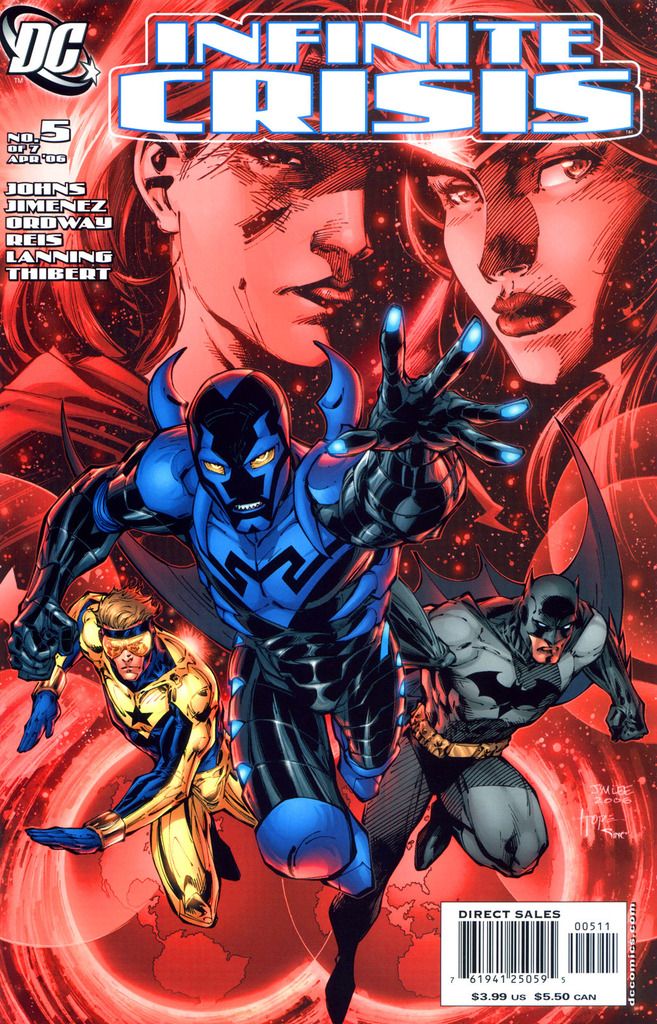 Once
The Flash of Two Worlds had got out (and gotten a good response) the cat was
out of the bag and new earths began popping up whenever the writer felt like it
– most notably Earth-3 where the equivalents of the Justice League were
villains called the Crime Syndicate of Amerika. When DC bought Quality Comics’
characters (which have actually fallen into the Public Domain) and began
publishing Fawcett Comics characters (which they later also bought) they were
given Earths of their own too – Earth-X and Earth-S aka Earth-10 and Earth-5
and of course their funny animal superheroes in Captain Carrot & His
Amazing Zoo Crew took place on yet another Earth. By the mid-80’s it was
decided this was way too complicated (cos it was) and in 1986 the comic series
Crisis on Infinite Earths destroyed the Multiverse and created one single
universe and Earth where all their books should now take place, and as part of
all this DC folded in the characters who had recently been acquired after the
purchase of Charlton Comics (Captain Atom, The Question etc) but not before
showing that they also had an Earth in the Multiverse. BUT DC still continued
to publish stories not set in this reality (Watchmen, Batman: The Dark Knight
Returns), these series would later be branded ‘Elseworlds’ and concept called
Hypertime was introduced to explain how they existed while a Multiverse did not
and how they could come to interact with the main Earth.
Once
The Flash of Two Worlds had got out (and gotten a good response) the cat was
out of the bag and new earths began popping up whenever the writer felt like it
– most notably Earth-3 where the equivalents of the Justice League were
villains called the Crime Syndicate of Amerika. When DC bought Quality Comics’
characters (which have actually fallen into the Public Domain) and began
publishing Fawcett Comics characters (which they later also bought) they were
given Earths of their own too – Earth-X and Earth-S aka Earth-10 and Earth-5
and of course their funny animal superheroes in Captain Carrot & His
Amazing Zoo Crew took place on yet another Earth. By the mid-80’s it was
decided this was way too complicated (cos it was) and in 1986 the comic series
Crisis on Infinite Earths destroyed the Multiverse and created one single
universe and Earth where all their books should now take place, and as part of
all this DC folded in the characters who had recently been acquired after the
purchase of Charlton Comics (Captain Atom, The Question etc) but not before
showing that they also had an Earth in the Multiverse. BUT DC still continued
to publish stories not set in this reality (Watchmen, Batman: The Dark Knight
Returns), these series would later be branded ‘Elseworlds’ and concept called
Hypertime was introduced to explain how they existed while a Multiverse did not
and how they could come to interact with the main Earth.
Then,
for the anniversary of Crisis on Infinite Earths, DC published a huge event
called Infinite Crisis, one of the effects of that story was that the
Multiverse was reborn, and each Earth was then made unique in the event’s
follow-up series 52, a comic book Grant Morrison co-wrote. This Multiverse was
NOT the same one as before, though several old Earths like Earth 2, 3, 5 and 10
were recreated and it was for this version of the Multiverse (Multiverse-2)
that Multiversity was originally planned for. However in 2011 DC revamped its
whole universe under the title of the ‘New 52’ completely recreating it’s
continuity (in a completely haphazard fashion) and amongst that was a new
Earth-2 and later a new Earth-1 (the ‘main’ DC Earth having been called Earth-0
since Infinite Crisis) so thus there was now a third version of the Multiverse.
Multiversity was the first series to explore this new Multiverse but its
creation is detailed in the 2015 event Convergence, meaning that Multiversity
takes place after that story despite being published a year before it (that’s
comics for you).
As
an additional note the realities/earths that existed prior to Multiveristy but
are revealed to exist (often in a new form) in the third Multiverse are:
Earth-0 (New 52 version of the main DC Earth); Earth 1 (setting of the Earth 0
series of graphic novels); Earth-2 (setting of the series Earth 2); Earth 3
(new version of Earth 3, first shown in the Forever Evil event); Earth 4 (new
version of the home of the Charlton Comics characters, hinted at in Final
Crisis); Earth-5 (new version of the home of the Fawcett Comics characters);
Earth-6 (setting for the Just Imagine…Stan Lee Creating the DC Universe books);
Earth-8 (new version of Angor, which dates back to the 1970s and is based on
Marvel Comics’ universe); Earth 9 (setting for the Tangent Comics books of the
1990s); Earth-10 (new version of the home of the Quality Comics characters and
the Earth that Overgirl from Final Crisis originated from); Earth-12 (setting
for the DC Animated Universe – Batman: The Animated Series, Justice League
Unlimited, Batman Beyond etc); Earth-15
(the earth destroyed by Superman –Prime in Countdown to Final Crisis); Earth-17
(setting of Batman: Gotham by Gaslight and others); Earth-18 (new version of the setting from
Justice Riders); Earth-21 (setting of DC: The New Frontier); Earth-22 (setting
of Kingdom Come); Earth-23 (the home of the Black Superman from Final Crisis
and Grant Morrison’s Action Comics run); Earth-26 (new version of the home of
Captain Carrot & His Amazing Zoo Crew); Earth-29 (new version of Bizarro World);
Earth-30 (setting of Superman: Red Son); Earth-32 (setting of Batman: In
Blackest Knight); Earth-33 (our universe, known as Earth-Prime); Earth-37
(setting of Batman: Thrillkiller); Earth-33 (setting of Superman & Batman:
Generations); Earth-43 (setting of the Batman: Red Rain trilogy); Earth-44 (the
Metal League appeared in Final Crisis); Earth-47 (new version of the home of
Sunshine Superman from Morrison’s run on Animal Man); Earth-48 (new version of
the home of Lady Quark from Crisis on Infinite Earths); Earth-50 (home of the
Justice Lords from the Justice League cartoon’s story ‘A Better World’) and
Earth-51 (new version of the setting of Kamandi).
On
that: beyond the essential 7 earths (0, 2, 3, 4, 5, 10 and 33/Prime) every
surviving reality it chosen purely on popularity power and in the most cases I
agree with the consensus here – if they’d left off any of these universe
(except maybe the one based on Generations and the Justice Lords) I’d’ve been
pissed off – especially as the New 52 had already taken away the main realities
we’d been following for our entire lives, to then cut things like the Kingdom
Come or Animated universes out too would have just been taking things as ‘too
far’ as possible. BUT there are some universes I would have liked, and would
have thought would have survived – there’s no universe for either the Teen
Titans or Young Justice TV series, nor for Superfriends and there’s no universe
for the Dark Knight Returns books; I suppose you could argue that Teen Titans
takes place in the DCAU (though that’s never been clear) but the other three
should have been shoe-ins from the start, especially as Young Justice was on TV
at the time.
Anyway
with all that out the way, are you sitting comfortably? Then I’ll begin.
The Curse of Superman (Action Comics Volume 2 issue 9)
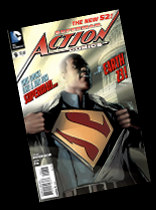 Quick Summary: on Earth-23
Superman defeats Lex Luthor’s Warsuit and finds his Transmatter Cube, as he
investigates three people – a woman and two dying men, one named Clark, appear
through the cube. The woman tells Superman her tale, Clark came back from
travels abroad with tales of using sound and thought to create things from
nothing, needing funding to create their Superman they sold out to Overcorp who
created Superdoomsday – a violent troubled anti-hero with a dark past with
cross-spectrum market appeal. It went on a rampage through universes and is
it’s here now. Superman stands his
ground initially but is knocked down, so enter: Luthor, armed with the woman’s
K-Blaster and stuffs it into Super Doomsday’s eyes, blasting him and allowing
Superman to get his second wind and trap the monster between frequencies in the
Transmatter Cube. The Justice League come and take the cube away and asks the
woman to stay, her companions having died, he asks her name ‘Lois Lane’ she
replies ‘and you must be Superman done right’.
Quick Summary: on Earth-23
Superman defeats Lex Luthor’s Warsuit and finds his Transmatter Cube, as he
investigates three people – a woman and two dying men, one named Clark, appear
through the cube. The woman tells Superman her tale, Clark came back from
travels abroad with tales of using sound and thought to create things from
nothing, needing funding to create their Superman they sold out to Overcorp who
created Superdoomsday – a violent troubled anti-hero with a dark past with
cross-spectrum market appeal. It went on a rampage through universes and is
it’s here now. Superman stands his
ground initially but is knocked down, so enter: Luthor, armed with the woman’s
K-Blaster and stuffs it into Super Doomsday’s eyes, blasting him and allowing
Superman to get his second wind and trap the monster between frequencies in the
Transmatter Cube. The Justice League come and take the cube away and asks the
woman to stay, her companions having died, he asks her name ‘Lois Lane’ she
replies ‘and you must be Superman done right’.
Subtle
Grant, subtle; but not wrong as far as I’m concerned Calvin Ellis IS Superman
done right, frankly he’s the best version of Superman we’ve ever had. Yes I
said that, and I mean it – see Superman has never been ‘cool’, heroic, iconic,
awesome, yes but he’s always lacked the ‘cool factor’ that Batman has in spades
and most attempts to give him that (like Nolan’s Man of Steel) have been to
make him grimmer and grittier – more like the undoubtedly cool Batman – and
it’s never worked because it flies in the face of what Superman is, it hasn’t
made him cool, just made people think the creators missed the point of
Superman. Morrison has figured out how to solve this problem – he’s combined
everything that makes Superman Superman with everything that makes a cool black guy and bam, coolest Superman
ever and thus for my money, the best version of Superman ever
The
story’s a nice little hint at things to come but all the ‘dark 90’s angsty
heroes suck’ theme seems a little hypocritical coming from a book published in
the first year of the New 52, which featured the DC characters at their least
clean-cut, heroic and iconic ever and was rifle with unnecessary darkness,
violence, extreme-super-cool-laughably designed characters, secret
organisations, sexism and bullshit.
Morrison’s
writing here is far better than it’ll be in Multiversity #1, it’s legible for a
start. Despite a bunch of buzzwords here and there it’s easy to follow and not
at all confusing, and shows just how much he gets Superman and Luthor, Luthor’s
opening lines ‘I’m not racist, it’s everything else about you I hate’ and his
fight (and dialogue therein) with Superdoomsday is just…so Luthor. Gene Ha did
the art as well and Gene Ha is amazing.
The House of Heroes (The Multiversity issue 1)
Quick-ish summary: on
Earth-Prime* Superjudge – the last of the Post-Infinite Crisis Monitors – is
about to perform a live review of a supposedly haunted comic from DC Comics
(Ultra Comics #1) over the internet (in his secret identity) then reality warps
and Superjudge and Mr Stubbs (his pirate chimp sidekick) go to Earth-7 to
investigate a distress call*. On Earth-7 they find that reality is out of tune,
physics are broken and most that world’s heroes are dead – only Thunderer
remains, standing alone against Intellectron. It turns out that the Gentry
summoned Superjudge to trap him, he orders Thunderer to escape to the House of
Heroes and is then trapped as earth-7’s reality folds down and we meet the
Gentry in full – Intellectron, Hellmachine, Dame Merciless, Lord Broken and
Demogorgunn. Superjudge then wakes up in his human form in a completely
different place in his room because fuck story continuity.
On earth-32 Barak Obama Superman defeats a robot with
odd physical properties then attends to a meeting as his AE President Calvin
Ellis. Once presidential stuff is over with he attends a Justice League meeting
where Steel has investigated in the robot and thinks it’s a probe from another
world and it’s drawn to the Transmatter Symphonic Array or Transmatter Cube
that this world’s Lex Luthor made. That cube then gets all excited and Superman
is teleported to the House of Heroes, where he meets Captain Carrot, who
explains the situation: Thunderer sent out an S.O.S and the House responded by
bringing heroes from all over the world – Dino-Cop and Spore* being the first. When
Superman tries to interface with the House’s A.I. via his Brainiac programme he
sets of Harbinger, a computer. Harbinger’s been turned off since before the
Mintors were gone so it takes ‘her’ a minute to sort ‘herself’ out then she
establishes the threat in the hammiest way possible. Superman decides to take a
team to help stop this great threat – himself, Thunderer, Aquawoman, Red Racer
and Captain Carrot with Dino-Cop acting as Oracle – Red Racer establishing the
‘one world’s reality is another’s fiction – specifically comics book fiction’
to Supes as they go to the Ultima Thule. Superman figures out how to fly it but
because there’s no sound affects it looks like he’s talking about something he
isn’t doing , they’re apparently attacked but we don’t see it.
On Earth-8 Lord Havok is
using the Omni-Gauntlets and Wandajin’s axe to open the Genesis Egg, then
Thunderer punches Wandajin in the face, The American CrUSAder think they’re
working with Lord Havok so they attack them (hey, this universe Is based on the
Marvel Universe, what do you expect?). Captain Carrot decks The Behemoth
because you don’t fuck with cartoon physics then Lord Havok hatches the Genesis
Egg, and from it comes The Superjudge, now a member of the Gentry (and just
going by his regular name of Nix Uotan). Oh Shit.
I
have made this sound a lot more legible than it actually is to read.
Establishing
shots Grant, fucking hell man – establishing shots! This is a problem of
Morrison’s that showed up in Final Crisis and Batman too, sometimes he will
just miss out panels showing an important action happening, have panels arranged
in a way that the focus of the conversation or event isn’t focused on or worse,
just miss out an establishing shot to tell us where we are, what’s happened or
what we’re talking about; this is – I believe – done in the name of not
insulting the reader’s intelligence (not everything needs a caption box
explaining what we can clearly see) but sometimes, in fact often, it just makes
things confusing or causes a break in the flow leaving readers (or at least me)
unsure what the fuck is happening, and as this book is already existential, metaphysical
and metaphorical cutting down the confusing is the way to go, not ramping it up
just with a needless stylistic choice. It’s bad during the shift from
Earth-Prime to the Ultima Thule, we don’t see the stuffed monkey turn into
Stubbs and we don’t get an establishing shot of either the Ultimate Thule or
its interior (I think they move straight to its interior) so if you haven’t
read Superman: Beyond 3D – where the Ultima Thule wasn’t even associated with
Nix Uotan – you have no idea what Stubbs, a character who seemingly just
appeared out of nowhere, is talking about or how they get to Earth-7. But it’s
worst when Superman’s team arrive on Earth-8, Havok is talking without any
background or indication that he’s standing near anyone, then there’s a flash
of light from him breaking Wandajin’s axe, then the next page Thunderer’s out
of the Ultimate Thule, punching Wandajin and the Retaliators are there out of
nowhere then Lord Havok is fighting the Fantastic Four analogues – we have no
idea where anyone is relation to anyone else and everything jumps about and
feels like there’s panels missing throughout, it’s badly plotted, written and
paced regardless of who’s written or drawn it. There’s a big difference between
not stating the obvious and not doing your job properly – your job, gentlemen,
being to tell us a story we can follow in the medium of sequential art.
For
balance – every major character introduced (or reintroduced) before Earth-8 is
awesome and I instantly liked them all. We’ve seen Calvin Ellis Superman before
and he was cool, he’ll be cool here. As
for the others, well Dino-Cop mixes The Savage Dragon with dinosaurs and
Aquawoman takes everything from Geoff John’s badass post-Blackest Night Aquaman
and makes it sexy so they’re both instant successes in my eyes. I don’t like
either Captain Carrot or Red Racer’s costumes very much, they’re exactly the
sort of modern over-detailed ‘realistic’ superhero costumes I want to see die
in a fire but Captain Carrot has always been awesome in an ironic sort of way
and now Morrison makes him awesome in every way possible while Red Racer is
such a nice bloke you can’t help but like him. Thunderer I was initially pissed
off with because I thought he’d replaced Wandajin but then that was found to
not be the case so I got over it, his costume isn’t as nice as Aquawoman or
Superman’s but better than Captain Carrot and Red Racer’s, it lacks all the
annoying ‘realistic’ modern elements but just looks a little bit awkward, as a
character though he comes across as a great bloke and a legitimately powerful
hero – plus there just ain’t enough Australasian superheroes (let alone
Aboriginal ones) so he gets points there too. The Gentry are magnificent, the
best kind of Vertigo-esque designs drawn by a bloke who draws gruesome fantastically,
a wasted gruesome woman, a sentient house filled with unspeakable horrors (and
huge eyes), a space monster with a city on its back, a moving mass of dead
bodies and…Intellectron, a flying egg eyeball with bat wings; four metal covers
and the logo for the band. Things go downhill a bit once we reach Angor Earth-8, the new Retaliators designs
are pretty weak and the Not-Fantastic Four designs aren’t even worth talking
about, the exception is the Behemoth – a giant blue monster baby, while pretty
childish in concept (the Hulk’s a big baby, all he does is have tantrums, hurr
hurr satire) looks fantastic in execution but the rest is pretty poor –
especially Lord Havok. ‘The Extremists Vector’ is one of my favourite comic
stories (no, really) and I am very protective and very critical when concepts
from it are used elsewhere (like that horrible Countdown: Arena) but even
unbiased the designs of the Extremists (by Bart Sears, I think?) were
fantastic, they were clearly equivalents of Marvel villains without feeling
derivative, they didn’t look like alternate costumes for Dr Doom, Dormammu,
Sabretooth etc, this new costume for Lord Havok does, it’s crap, it’s
uncreative and nowhere near as good as the original, or even the horned version
from Countdown, and frankly if you’re not as good as something from Countdown,
you are beyond hope.
Oh
yeah, Ivan Reis is on art – he’s a good artist, he has a pleasing style – he
was great on Blackest Night and he’s very good at the gruesome and horrific
while still being able to draw clean, classic superheroes that don’t look in
anyway macabre (unlike say, Kelley Jones or Brian Finch) meaning he’s perfect
for this story and perfect to draw The Gentry. He does scrimp on details, especially
background details, sometimes which are a problem in a book like this
especially with Grant Morrison using this style or writing – really these
universe spanning event books should go to the more detail obsessed artist in
the George Perez vein.
But
the book’s just fucking confusingly written, in fact I was so disappointed that
it carried over all the worst traits of Final Crisis that I was going to just
give up on the whole story but I read part 2 anyway and it does get better and
more legible (more ‘standard’ I guess) so I stuck with it, I’m glad I did. This
issue however is riddled with Grant Morrison’s worst attributes at DC – hinting
at things rather than making it clear when hinting doesn’t build atmosphere,
isn’t needed for story purposes and is just being done for the sake of it; the
confusing plotting and the feeling that panels have been missed out; cock-eyed
pacing; having dialogue make matters worse by throwing in made up buzzwords
(seriously the whole JLA scene is made 5 times harder to read by having
characters talk bollocks rather than a language we can understand); focussing
on things that aren’t plot relevant just so the reader has to work out things
when working things out isn’t necessary for that part of the story, god it’s
like Final Crisis but without all of the familiar elements of Earth-0 to help
you along. There’s also just random bits of bad writing – Thunderer knows Nix
Uotan’s in the Genesis Egg (how?), we never see the signal for help from
Earth-7 come in – and there’s NO FUCKING SOUND EFFECTS. Nothing makes things
more confusing, and makes the characters look madder, than no sound
effects.
Next
time: We meet some of the new earths, Morrison finally tells a Doc Fate story
and I want to have sex with Lex Luthor’s daughter.
* This is my guess, the Earth
isn’t stated but as DC Comics exist here so I’m guessing it’s Earth-33 aka
Earth-Prime, the real world as it were.
*it’s all a bit confusing
really: Superjudge and Stubbs switch realities and go to the Ultima Thule –
which I think is in the House of Heroes in Bleedspace (it’s never said) – to
investigate where the ideas for this haunted comic come from as they know that
one universe’s comics is another’s reality (that’s never said) – they then go
to Earth-7 presumably on this mission but then say they were called to help by
an S.O.S. (sent by the Gentry) , as there’s no sound affect (in general) and
we’re never shown them receiving this distress call I have no idea, it’s like a
page is missing, a common feeling in Morrison’s DC work after he started on
Batman.
* DC’s new equivalents of
The Savage Dragon and Spawn from Image Comics.

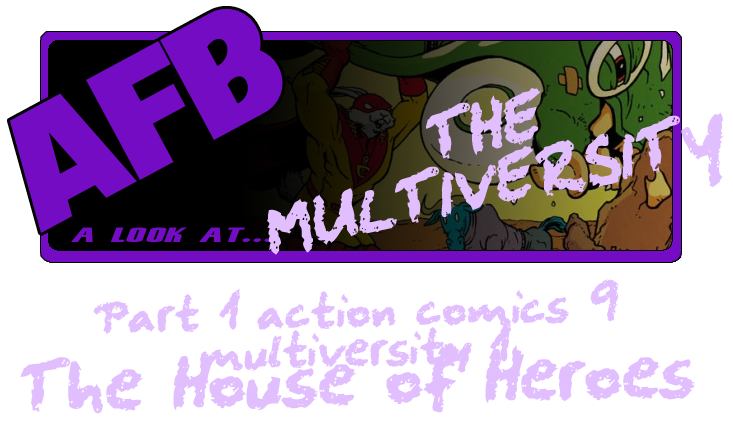
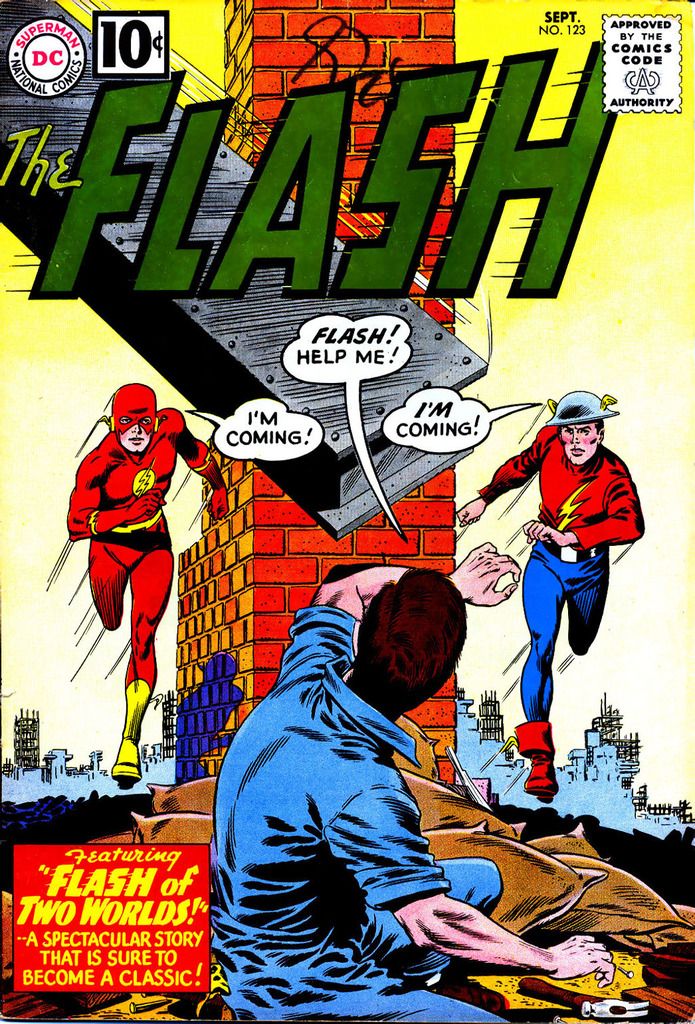
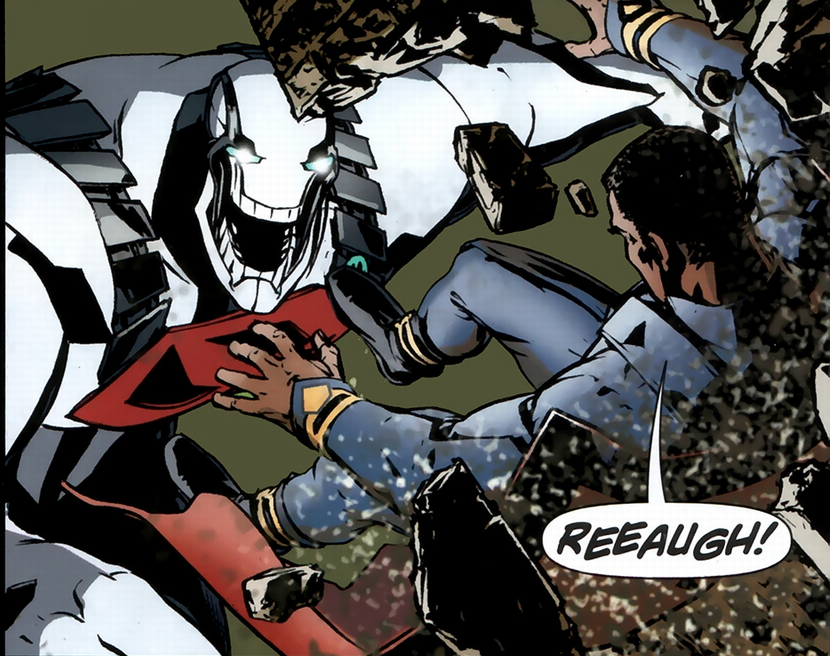

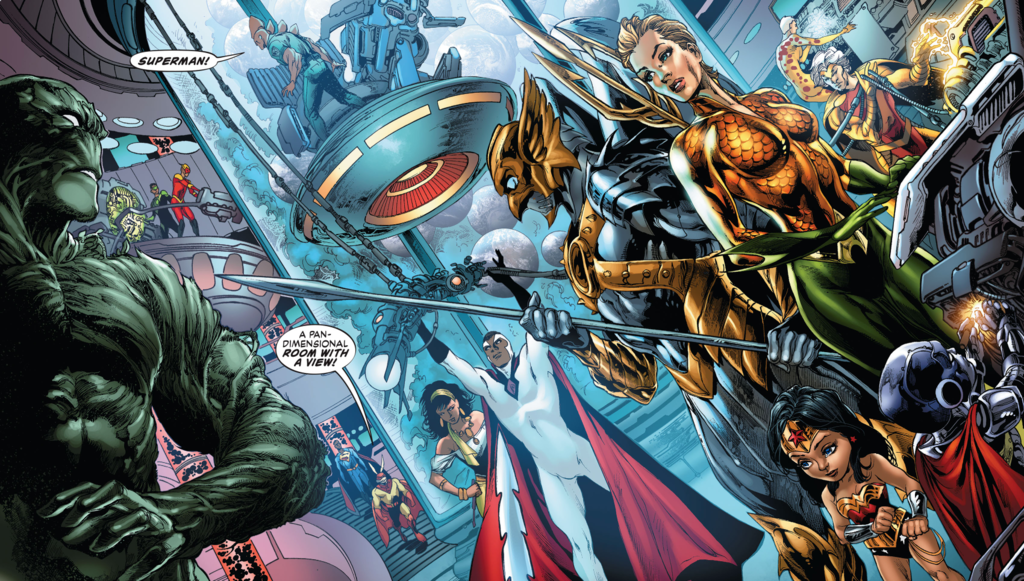
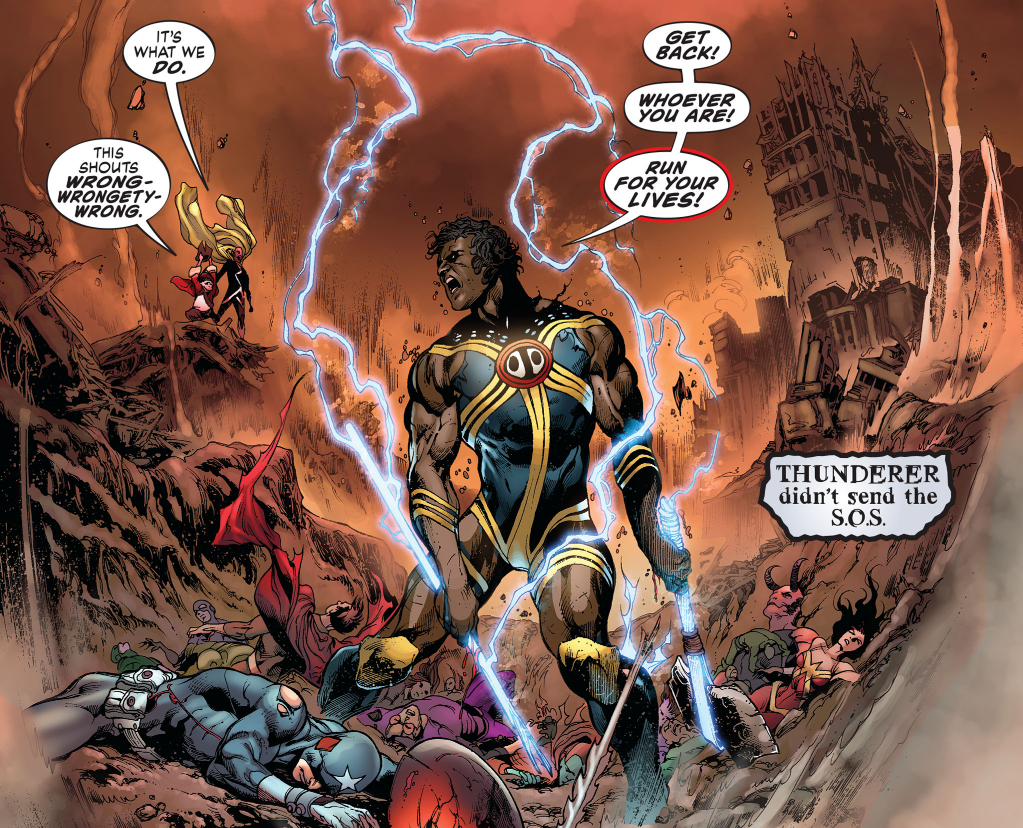


No comments:
Post a Comment